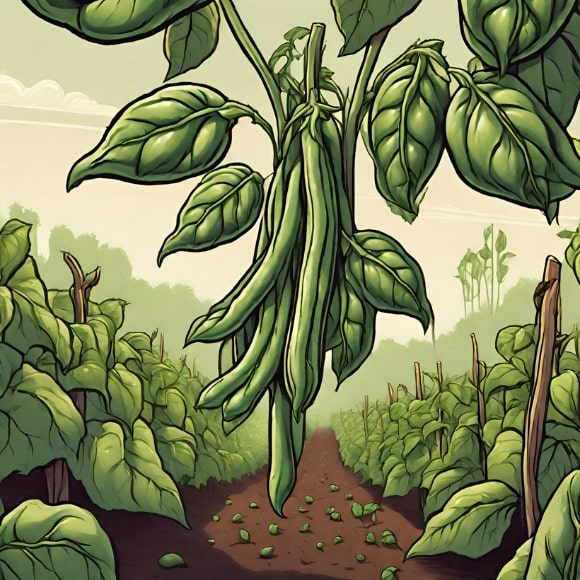
Green beans, also known as snap beans or string beans, are a popular vegetable in home gardens. With their tender pods, crisp texture, and fresh flavor, green beans are a staple in salads, stir-fries, casseroles, and more. Read on to get the basics of growing green beans as we explore their soil, sun, and watering requirements, as well as the optimal plant hardiness zones for cultivating this delicious vegetable.
Soil Requirements
Green beans thrive in well-drained, fertile soil with a slightly acidic to neutral pH range of 6.0 to 7.0. Soil that is too acidic or alkaline can hinder nutrient uptake and lead to poor growth and yield. To ensure optimal soil conditions for green beans, amend heavy clay soils with organic matter such as compost, aged manure, or peat moss to improve drainage and fertility. If your soil composition calls for it, you can also use a balanced fertilizer to help promote healthy plant growth and abundant pod production.
Sun Requirements
Green beans are sun-loving plants that require full sun to thrive, meaning they should receive at least 6-8 hours of direct sunlight per day. In regions with hot Summers, providing some afternoon shade can help protect green bean plants from excessive heat stress and sunburn. Too little sunlight can result in leggy growth, reduced flowering, and poor pod set, so it’s essential to choose a sunny location for planting green beans.
Watering Requirements
Consistent and adequate watering is crucial for the health and productivity of green bean plants. While green beans require regular moisture, they are susceptible to waterlogged conditions, which can lead to root rot and other diseases. The frequency of watering will depend on factors such as soil type, weather conditions, and stage of plant growth. As a general rule, green bean plants should be watered deeply, providing enough moisture to saturate the root zone, but allowing the soil to dry slightly between waterings to prevent waterlogged conditions. Mulching around green bean plants with organic materials such as straw or shredded leaves can help conserve soil moisture, regulate soil temperature, and suppress weed growth.
Plant Hardiness Zones
Green beans are warm-season crops that thrive in USDA plant hardiness zones 3-10, with variations depending on the specific cultivar. Gardeners in colder climates can extend the growing season by starting green bean seeds indoors or transplanting seedlings after the threat of frost has passed. Additionally, selecting cold-tolerant green bean varieties and using season-extending techniques such as row covers or hoop houses can help mitigate the risk of frost damage in cooler regions.
Exploring America’s Favorite Green Bean Varieties
Green beans, also known as snap beans or string beans, are a popular vegetable in American gardens and kitchens, prized for their tender pods, fresh flavor, and culinary versatility. With a multitude of green bean varieties available, it can be challenging to decide which ones to grow. We’ll explore five of the most popular green bean varieties in the United States, highlighting their primary uses and growing seasons to help you choose the perfect beans for your garden.
Blue Lake
Blue Lake green beans are perhaps the most iconic and widely grown variety in the United States, known for their straight, slender pods, crisp texture, and sweet, flavorful taste. These beans are perfect for fresh eating, steaming, stir-frying, and canning. Blue Lake green beans typically mature in approximately 55 to 60 days from planting to harvest. With their vigorous vines and prolific yields, Blue Lake green beans are a staple in home gardens.
Kentucky Wonder
Kentucky Wonder green beans are a classic heirloom variety prized for their long, slender pods, meaty texture, and rich, nutty flavor. These beans are perfect for steaming, sautéing, grilling, and adding to soups and stews. Kentucky Wonder green beans typically mature approximately 60 to 65 days from planting to harvest. With their robust plants and abundant yields, Kentucky Wonder green beans are a favorite among home gardeners.
Provider
Provider green beans are a popular bush variety known for their compact growth habit, early maturity, and consistent yields. These beans produce straight, round pods with a tender texture and mild, sweet flavor. Provider green beans are perfect for fresh eating, steaming, stir-frying, and freezing. Provider green beans typically have a relatively short growing season, maturing approximately 50 to 55 days from planting to harvest. With their compact size and early harvest, Provider green beans are an excellent choice for gardeners who want a quick and reliable crop.
Contender
Contender green beans are a reliable and productive bush variety known for their disease resistance, high yields, and excellent flavor. These beans produce straight, round pods with a tender texture and rich, nutty taste. Contender green beans are perfect for fresh eating, steaming, stir-frying, and canning. Contender green beans typically mature approximately 55 to 60 days from planting to harvest. With their disease-resistant nature and prolific yields, Contender green beans are a top choice for home gardeners.
Topcrop
Topcrop green beans are a classic bush variety known for their compact growth habit, early maturity, and consistent yields. These beans produce straight, round pods with a tender texture and mild, sweet flavor. Topcrop green beans are perfect for fresh eating, steaming, stir-frying, and freezing. Topcrop green beans typically have a relatively short growing season, maturing approximately 50 to 55 days from planting to harvest. With their compact size and early harvest, Topcrop green beans are an excellent choice for gardeners seeking a quick and reliable crop.


 Previous
Previous

